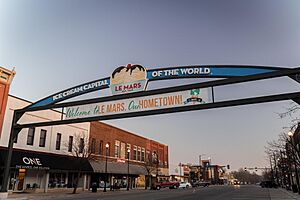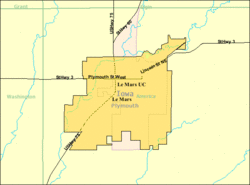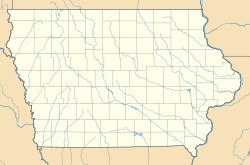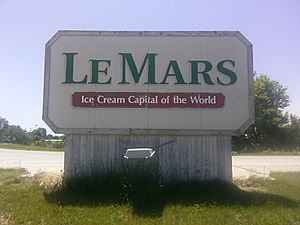Le Mars, Iowa facts for kids
Quick facts for kids
Le Mars, Iowa
|
|
|---|---|
 |
|
| Nickname(s):
"Ice Cream Capital Of The World"
|
|

Location of Le Mars within Plymouth County and Iowa
|
|

U.S. Census Map
|
|
| Country | |
| State | |
| County | Plymouth |
| Government | |
| • Type | Mayor-council |
| Area | |
| • Total | 8.55 sq mi (22.14 km2) |
| • Land | 8.54 sq mi (22.12 km2) |
| • Water | 0.01 sq mi (0.03 km2) |
| Elevation | 1,234 ft (376 m) |
| Population
(2020)
|
|
| • Total | 10,571 |
| • Density | 1,238.26/sq mi (478.10/km2) |
| Time zone | UTC-6 (Central (CST)) |
| • Summer (DST) | UTC-5 (CDT) |
| ZIP code |
51031
|
| Area code(s) | 712 |
| FIPS code | 19-44400 |
| GNIS feature ID | 0458255 |
Le Mars is a city in Plymouth County, Iowa, United States. It's also the main town, or county seat, of Plymouth County. Le Mars is located near the Floyd River, northeast of Sioux City. In 2020, about 10,571 people lived there. The city is part of the larger Sioux City metropolitan area.
Contents
History of Le Mars
Le Mars is famous for being the "Ice Cream Capital of the World." This is because it's home to Wells Enterprises, Inc., which is one of the biggest ice cream makers in one location!
The first settler in the area was Benjamin F. Betsworth in 1866. He built the town's first school. Le Mars was officially planned out three years later. But no land was sold until a railroad company finished its tracks from Le Mars to Sioux City in 1870.
The town was first called St. Paul Junction because of its railroad connection to St. Paul. A railroad leader named John I. Blair asked some women on a trip to name the town. They used the first letters of their names to create "Le Mars." The letters stood for: Lucy, Laura, Ellen or Elizabeth, Martha, Mary, Adeline, Rebecca, and Sarah.
In 1885, a young Englishman named Frederick Brooke Close started the Northwestern Polo League in Le Mars.
During the Great Depression in 1933, many farmers were losing their farms. In Le Mars, over 500 farmers gathered at the courthouse. They wanted the judge to stop the process of taking away farms. The farmers felt strongly that the court should help them.
Le Mars is a popular stop for presidential candidates. Many important politicians, like George W. Bush, Joe Biden, Barack Obama, and Hillary Clinton, have visited the city during their campaigns.
Wells Enterprises: The Ice Cream Story
In 1925, Fred H. Wells Jr. and his sons started an ice cream factory in Le Mars. Later, in 1935, they wanted to sell ice cream again but couldn't use their old name. So, they held a contest to name their new ice cream. The winning name was "Blue Bunny" because the person's son loved seeing blue bunnies at Easter. In 2022, another company called Ferrero Rocher bought Wells Enterprises.
Today, the Wells' Blue Bunny Dairy plant is huge! It's about 900,000 square feet and has a tall 12-story refrigeration tower. This big plant makes millions of gallons of frozen treats every year. Most of the milk comes from large dairy farms in Iowa. Because of this huge factory, Le Mars is known as the "Ice Cream Capital of the World."
Wells Enterprises makes many popular treats like Blue Bunny, Bomb Pop, and Blue Ribbon. To celebrate its sweet history, Le Mars has an amazing ice cream parlor. It was updated in 2019 and looks like an old-fashioned ice cream shop. It also has museum displays, rooftop seating, and a gift shop. This ice cream parlor is one of the biggest tourist spots in Iowa!
Every year in late June, Le Mars hosts a fun event called "Ice Cream Days." It includes ice cream parties, concerts, art shows, parades, and more!
Geography and Climate
Le Mars is located at 42°47′20″N 96°9′57″W / 42.78889°N 96.16583°W. The city covers about 8.55 square miles, with most of it being land and a very small part being water.
Climate in Le Mars
Le Mars experiences different seasons throughout the year. Here's a quick look at the weather:
| Climate data for Le Mars, Iowa (1991−2020 normals, extremes 1896−present) | |||||||||||||
|---|---|---|---|---|---|---|---|---|---|---|---|---|---|
| Month | Jan | Feb | Mar | Apr | May | Jun | Jul | Aug | Sep | Oct | Nov | Dec | Year |
| Record high °F (°C) | 68 (20) |
70 (21) |
87 (31) |
96 (36) |
108 (42) |
106 (41) |
111 (44) |
108 (42) |
103 (39) |
97 (36) |
80 (27) |
68 (20) |
111 (44) |
| Mean maximum °F (°C) | 48.6 (9.2) |
54.8 (12.7) |
72.5 (22.5) |
83.6 (28.7) |
91.3 (32.9) |
94.1 (34.5) |
93.4 (34.1) |
92.4 (33.6) |
89.8 (32.1) |
84.7 (29.3) |
67.5 (19.7) |
52.0 (11.1) |
96.5 (35.8) |
| Mean daily maximum °F (°C) | 27.2 (−2.7) |
32.2 (0.1) |
45.9 (7.7) |
59.9 (15.5) |
71.7 (22.1) |
81.3 (27.4) |
84.5 (29.2) |
82.0 (27.8) |
75.8 (24.3) |
62.5 (16.9) |
45.7 (7.6) |
32.0 (0.0) |
58.4 (14.7) |
| Daily mean °F (°C) | 17.3 (−8.2) |
21.8 (−5.7) |
34.5 (1.4) |
47.0 (8.3) |
59.3 (15.2) |
69.8 (21.0) |
73.1 (22.8) |
70.5 (21.4) |
62.7 (17.1) |
49.7 (9.8) |
34.6 (1.4) |
22.4 (−5.3) |
46.9 (8.3) |
| Mean daily minimum °F (°C) | 7.4 (−13.7) |
11.4 (−11.4) |
23.1 (−4.9) |
34.2 (1.2) |
47.0 (8.3) |
58.3 (14.6) |
61.7 (16.5) |
59.0 (15.0) |
49.6 (9.8) |
36.9 (2.7) |
23.5 (−4.7) |
12.9 (−10.6) |
35.4 (1.9) |
| Mean minimum °F (°C) | −14.7 (−25.9) |
−8.9 (−22.7) |
2.0 (−16.7) |
19.5 (−6.9) |
33.5 (0.8) |
47.1 (8.4) |
50.9 (10.5) |
48.5 (9.2) |
34.6 (1.4) |
21.6 (−5.8) |
6.3 (−14.3) |
−8.2 (−22.3) |
−18.0 (−27.8) |
| Record low °F (°C) | −37 (−38) |
−35 (−37) |
−26 (−32) |
−2 (−19) |
17 (−8) |
33 (1) |
38 (3) |
35 (2) |
22 (−6) |
−7 (−22) |
−24 (−31) |
−33 (−36) |
−37 (−38) |
| Average precipitation inches (mm) | 0.72 (18) |
0.87 (22) |
1.85 (47) |
3.07 (78) |
3.90 (99) |
4.64 (118) |
3.11 (79) |
3.95 (100) |
3.14 (80) |
2.40 (61) |
1.30 (33) |
1.04 (26) |
29.99 (762) |
| Average snowfall inches (cm) | 7.8 (20) |
7.5 (19) |
4.6 (12) |
1.9 (4.8) |
0.1 (0.25) |
0.0 (0.0) |
0.0 (0.0) |
0.0 (0.0) |
0.0 (0.0) |
0.4 (1.0) |
2.6 (6.6) |
6.0 (15) |
30.9 (78) |
| Average precipitation days (≥ 0.01 in) | 4.0 | 4.5 | 5.5 | 7.8 | 10.4 | 9.7 | 6.7 | 7.5 | 6.9 | 6.4 | 3.6 | 4.2 | 77.2 |
| Average snowy days (≥ 0.1 in) | 3.6 | 3.3 | 2.1 | 0.7 | 0.0 | 0.0 | 0.0 | 0.0 | 0.0 | 0.4 | 1.3 | 3.4 | 14.8 |
| Source: NOAA | |||||||||||||
People of Le Mars
| Historical population | |||
|---|---|---|---|
| Census | Pop. | %± | |
| 1890 | 4,036 | — | |
| 1900 | 4,146 | 2.7% | |
| 1910 | 4,157 | 0.3% | |
| 1920 | 4,683 | 12.7% | |
| 1930 | 4,788 | 2.2% | |
| 1940 | 5,353 | 11.8% | |
| 1950 | 5,844 | 9.2% | |
| 1960 | 6,767 | 15.8% | |
| 1970 | 8,159 | 20.6% | |
| 1980 | 8,276 | 1.4% | |
| 1990 | 8,454 | 2.2% | |
| 2000 | 9,237 | 9.3% | |
| 2010 | 9,826 | 6.4% | |
| 2020 | 10,571 | 7.6% | |
| U.S. Decennial Census | |||
Le Mars is part of the Sioux City metropolitan area.
How Many People Live Here?
In 2020, there were 10,571 people living in Le Mars. There were about 4,296 households, which are groups of people living together. Most people in the city were White (85.4%). About 9.5% of the population was Hispanic or Latino.
The average age of people in Le Mars was 38.1 years old. About 28.5% of residents were under 20 years old, and 16.9% were 65 or older. The population was almost evenly split between males (49.4%) and females (50.6%).
Education in Le Mars
Le Mars has two main school systems: a public one and a private one.
Le Mars Community School District
This is the public school district for Le Mars. It serves over 2,000 students from kindergarten through 12th grade. The school mascot is a bulldog.
Elementary Schools
- Clark Elementary School (Kindergarten to 5th grade)
- Franklin Elementary School (Kindergarten to 5th grade)
- Kluckhohn Elementary School (Kindergarten to 5th grade)
Middle School
- Le Mars Community Middle School (6th to 8th grade)
High School
- Le Mars Community High School (9th to 12th grade)
Other Learning Options
- Individualized Learning Center offers different ways to learn.
Gehlen Catholic Schools
Gehlen Catholic is a private school connected to the Roman Catholic Diocese of Sioux City. It serves over 350 students from kindergarten through 12th grade. Their mascot is a jay.
Elementary School
- Gehlen Catholic Elementary School
Middle School
- Gehlen Catholic Middle School
High School
- Gehlen Catholic High School
Westmar University (Closed)
Westmar University used to be a private four-year college in Le Mars. It closed permanently in 1997.
Getting Around Le Mars
Airports
The Le Mars Municipal Airport is owned by the city. It's located a short distance southwest of the city center.
Main Roads
- U.S. Route 75 runs north and south through Le Mars.
- Iowa State Highway 3 runs east and west through Le Mars.
- Iowa State Highway 60 starts on the north side of Le Mars and goes northeast towards Minnesota.
Fun Places to Visit in Le Mars
- Plymouth County Courthouse: An important government building.
- St. George's Episcopal Church: A historic church.
- Tonsfeldt Round Barn: A unique round barn listed on the National Register of Historic Places.
- Le Mars Public Library: A great place to find books and learn.
- Archie's Waeside: A famous steakhouse known for its delicious dry-aged beef. It has even won awards!
- The Wells Visitor Center and Ice Cream Parlor: This is a must-visit! It has an old-fashioned ice cream counter, fun displays, rooftop seating, and a gift shop.
- Bob's Drive Inn: A popular local restaurant for classic hot dogs and other "drive-in" foods. It's even won "Best Hot Dog in Iowa" by People's Magazine!
Famous People From Le Mars
- Clarence E. Coe: A pioneer who helped settle Palms, California.
- Bruce Dreckman: An umpire in Major League Baseball.
- Loyal M. Haynes: A Brigadier General in the United States Army who served in the Korean War.
- John Gregory Kelly: A Roman Catholic bishop.
- Clyde Kluckhohn: A professor of Social Anthropology at Harvard.
- Keith Knudsen: A drummer for the band Doobie Brothers.
- Jim Nicholson: A former Secretary of Veteran Affairs.
- Paul Rust: An actor and comedian known for shows like Love (TV series).
- Roger C. Schultz: A United States Army Lieutenant General.
- Thomas Starzl: A doctor famous for his work in organ transplant surgery.
See also
 In Spanish: Le Mars (Iowa) para niños
In Spanish: Le Mars (Iowa) para niños




